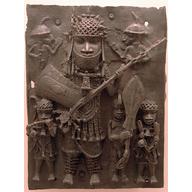African weapons were created for purposes that went far beyond their original functions.

They were usually made from copper and brass but mostly from Iron. They included swords, daggers, knives, spears, axes,
shields
etc. In most cases, a hammer and anvil were used to work the metals. Copper and brass lacked the solidity needed to make weapons for warfare. Blacksmiths needed more resistant metals to create stronger weapons. They found their answer with Iron and steel. The techniques used by the blacksmiths have not varied much over the years. Iron ore was melted in furnaces made of holes in the ground covered by round tops. In these furnaces, layers of metal were alternated with charcoal. With the use of bellows, the fires were kept burning for two to three days. After the mass of Iron mixed with slag has been removed and purified, it is worked again in the fire. Blacksmiths then hammer the metal into shape on an anvil to create various types of weapons. Most African weapons collected as art date from the end of the nineteenth and the beginning of the twentieth century. They are well crafted and most are highly ornamented, suggesting that they belonged to kings and other high ranking officials. It is widely believed that before being used, the weapons were blessed in various ritual ceremonies. In some cases, items believed to have magical powers were put in the handles and grips of various weapons to protect the warriors in times of battle and also increase their chances of victory. One of the most fascinating things about these weapons is the fact that not only were they made to defend against or attack the other tribes, they were also made from the use of simple tools like the hammer, anvil and chisels and the craftsmanship of highly skilled blacksmiths.

Return from African Weapons to Homepage
Learn More About Tribal African Weapons
Enjoy this page? Please pay it forward. Here's how...
Would you prefer to share this page with others by linking to it?
- Click on the HTML link code below.
- Copy and paste it, adding a note of your own, into your blog, a Web page, forums, a blog comment,
your Facebook account, or anywhere that someone would find this page valuable.
|





